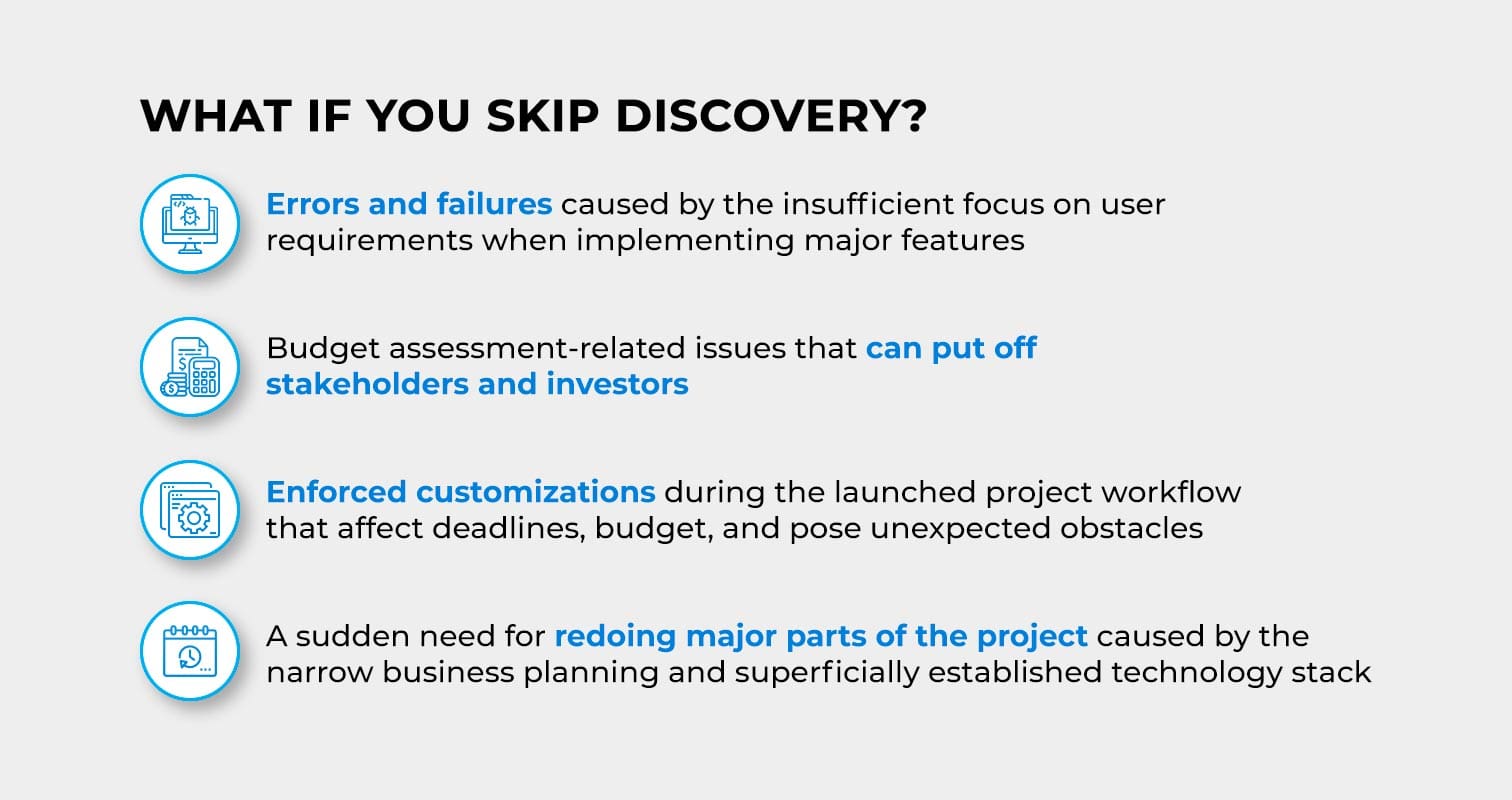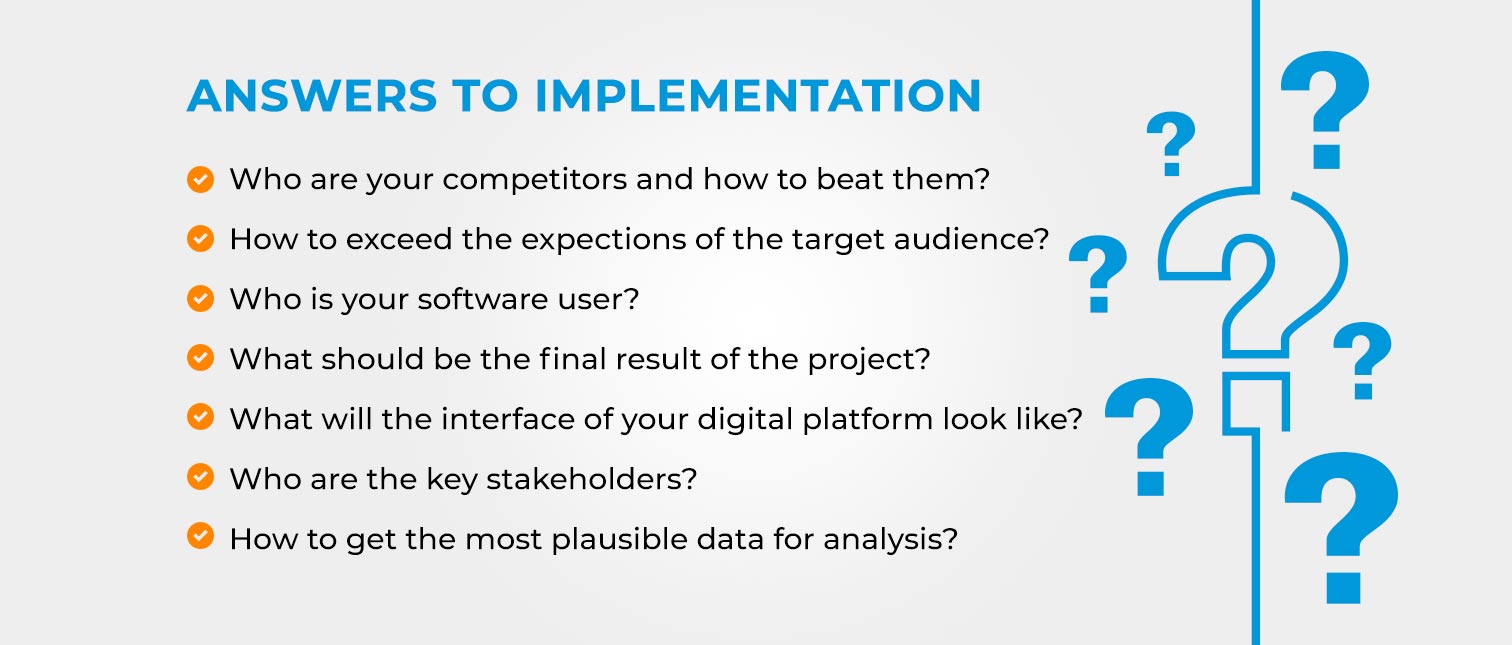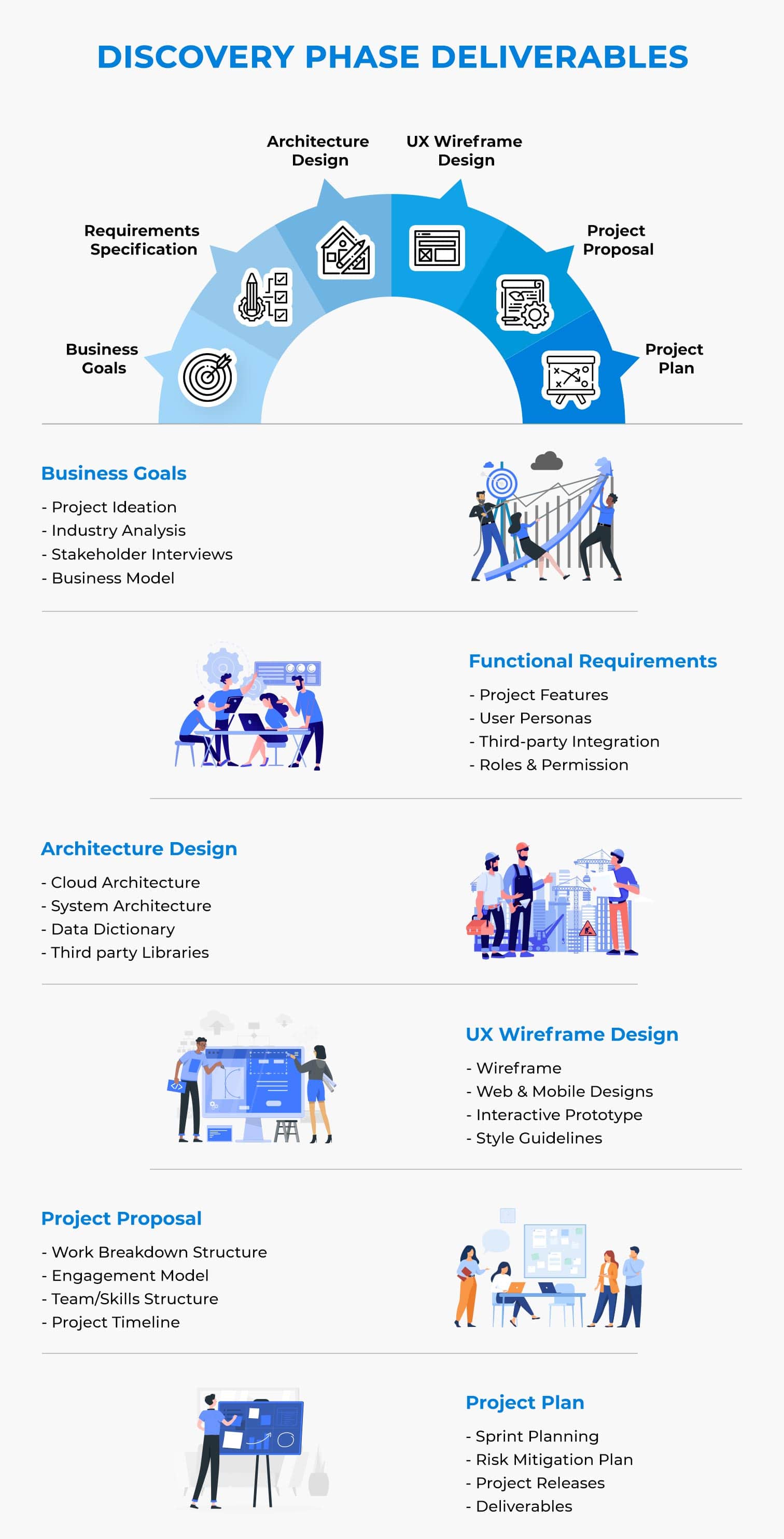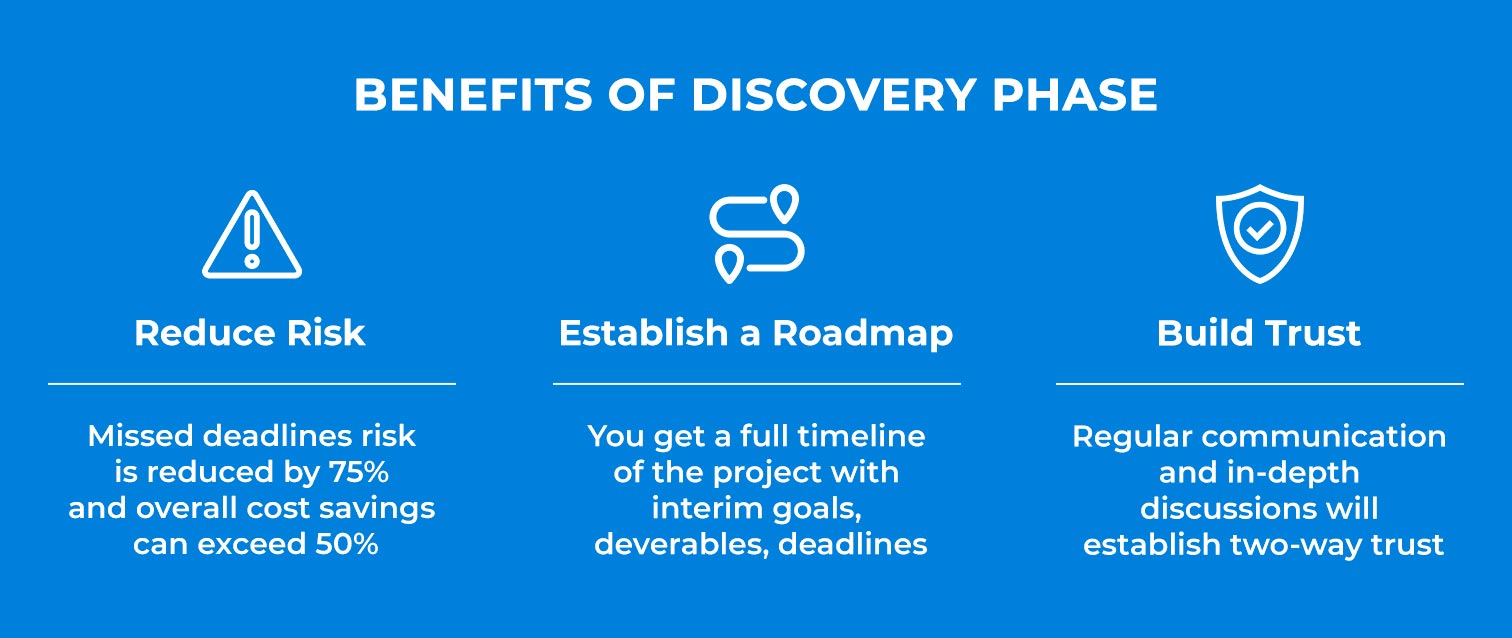According to McKinsey, around 17% of IT projects turn out so badly that they end up becoming the reason for the business collapse. However, many people are still skeptical about how the discovery phase helps to deliver a project without any scope for error.
The same thing happened with a company that intended to build software. The brief was sent to the customer acquisition department proposing the inclusion of the discovery phase and enclosed the discovery cost in the final quotation. The marketing team went ahead with $350,000, as the client was in touch with many vendors, jeopardizing the contact would be precarious.
However, the complete budget included a discovery phase cost of $25000 and a month. So, the client refused and asked to cut the discovery cost and make the final quotation.
Within 5 weeks the project turned chaotic, the prototype didn't suit the client's needs and was rejected. More budget was allocated to continue the project. But lack of documentation and using personal silos was concluding to poor results. The project was continued for several months and after paying $550,000 the client gave up the project.
According to an article by TechRepublic, 86% of software projects encounter failure due to various reasons.
Yes, building software that offers real-time solutions is a complex job. Thousands of lines of codes are written by multiple programmers from remote locations to form a single piece of software from start to end.
Reason behind the Failure of an Ambitious Project
There might be thousands of reasons but the most prominent one is the lack of discovery. The majority of stakeholders ignore this phase of project development and have to pay a hefty price for it later. Without a proper base, it becomes impossible to make a project work and this is where the discovery phase comes in.
This blog post deals with the basics of the discovery phase in project management and how it can be lethal if ignored.

So, What is the Discovery Phase?
Discovery or scoping phase is a procedure of collecting and analyzing information about a project, its intended audience, and the desired market. During this phase, your project partner needs to create an entire blueprint of your project.
In this phase, every team member gets to know some specific details including:
- Who needs the software
- What is the scope of the project
- User behavior and research
- What will define the project as a success
- What kind of competitions the project has to face
- What are going to be the interface features
- What tech platform should be employed to build the software
- The software will be cloud-based, web-based or mobile-based
- What will be the preferred technology used for the project
- Estimated date of delivery or a deadline
This phase might also include:
- Offline and online research
- A wireframe of the interface
- Brainstorming sessions and critical analysis
- Prototype of the app
- Blueprint confirmation and project work side by side
Who needs the Discovery Phase?
The Discovery phase is for all the stakeholders. Whether you are an individual software developer or an organization, you will have a greater work satisfaction and success rate. A business that needs the software for itself will have a more economical and efficient product.
The bottom line, discovery phase can save a lot of time as well as resources. A shelved project doesn't only cost effort and money but also leads to several missed opportunities businesses suffer due to not using or implementing the software.

What Activities are Involved in the Discovery Phase?
A discovery phase team comprises designers, business analysts, developers, and stakeholders who have the say on how the final version of the software would function. The activities involved in the development phase will offer a comprehensive understanding of what is required and how to achieve it.
This helps to comprehend the problem faced by stakeholders and how the software will solve their issues. The activities include

Common deliverables of the Discovery Phase
● Functional requirement documents
This document includes the details of the features or requirements that are needed to be implemented in the software. It defines that the solution is supposed to achieve data processing, data manipulation, and other functions that will be conducted digitally. Functional requirement documentation might incorporate related details like security details, performance requirements, and limitations within which the software app may have to function.
● Technical layout
The technical layout is the backbone of the entire software development process. It is generally the blueprint that takes the issue, dissects it, and then creates a software solution. If you have the technical design you have the entire picture in front of you. All you need now is to start with the coding.
● Advanced-level project plan
The advanced project plan maps out the scope of the project within the said timeline and budget. It is majorly management based and the stakeholders and project managers deal with the details within the project plan.
● Costing proposal for larger advancement step
Knowing the pricing of the entire software project as well as of individual stages is crucial for both the developers who are responsible for coding and the stakeholders. A cost proposal offers the stakeholders a clear idea of the investment over the timeframe it is needed to build, test, or install the software app. Further planning solely depends on the cost proposal.
What is the usual time frame needed for the Discovery Phase?
The usual time frame varies depending on the project. Normally, it can take up to 4 to 8 weeks based on the intensity of the software project.
Always keep in mind that a huge part of the process completes or occurs during the discovery phase. Once the development team has the blueprint, they know what needs to be done to build the software. Scope for confusion or lack of understanding can cause disasters and delays.
Repercussion of Excluding the Discovery phase in the Project Development Life Cycle
The price to pay for ignoring the discovery phase can be hefty and monumental. The entire process might be discarded. The development curve might go down, team members will have a hard time sticking to the schedule because of constant alterations and aimless changes.
The team will have no specific direction to move forward escalating the price. The chances of building a working software reduce with every preceding day.
Skipping the discovery phase can result in the following:
- Escalated cost- Undefined goals and requirements change the course of the process that is further associated with cost increment.
- Incessant scope creek- Lack of measurable expected or wanted results can lead to an incessant extension to project time that delays the release.
- Forfeited deadlines- Without specific project boundaries, the process timeline exceeds and postpones the launch.
- A project that does not meet up with the client's expectations- Misconceptions developed in the initial stage can create complex confusion down the line ruining both time and resources.
Benefits of a Discovery Phase for Application Development
The Discovery phase might look unwanted and a waste of time when you want the product up and running faster. But this step is important in successful software or app development.

● Reduced Risk
A thorough understanding of the requirements and goals helps the development team to form an accurate estimate of the budget and timeframe. The risk of delaying the deadline is curtailed by 75%. The cost savings can rise to 50%. Ultimately the discovery phase implies the success rate of a project.
● Establish a Roadmap
When the development team has a clear set of instructions for requirements, they can easily develop a plan and stick to it. You will receive a full timeline of the project with internal goals, deadlines, and deliverables.
● Build Trust
Even after a promising sales pitch, it is impossible to be cent percent sure if they made the right decision on hiring the IT vendor. Regular interaction and in-depth discussions with the team will ease the client and build trust. Alternatively, if you have realized you chose the wrong one, shift to another company before you lose resources and time both.
Conclusion
Brainvire, being a Software Development Company, clients have first-hand experience with the full-fledged benefits of the discovery stage. We offer demographic info about the targeted audience and help the client to assess and achieve short and long-term measurable goals. We align our approach to keep you ahead of your competitors with Brainvire’s competitive feature analysis and unique selling proposals.
Our experience has proven demonstration to be the turning point for projects. We’ve noticed numerous times that if the requirements of the project are identified before the coding and designing process, it significantly lowers the budget and turn around time for the project.
Unfortunately, in an attempt to save resources and time, the discovery aspect is often overlooked. When a firm tries to cut the discovery phase it actually exceeds the budget along with the timeline. Brainvire's discovery services can help you in bringing down the costs while shortening the development time.
Related Articles
Digital Transformation
Marketing Agency Costs: How Much to Invest in Digital Marketing for Your Business?
Digital Transformation
A Comprehensive Guide to Odoo Modules
Digital Transformation
Exploring the Future of AI in Real Estate: Trends and Predictions for 2025

